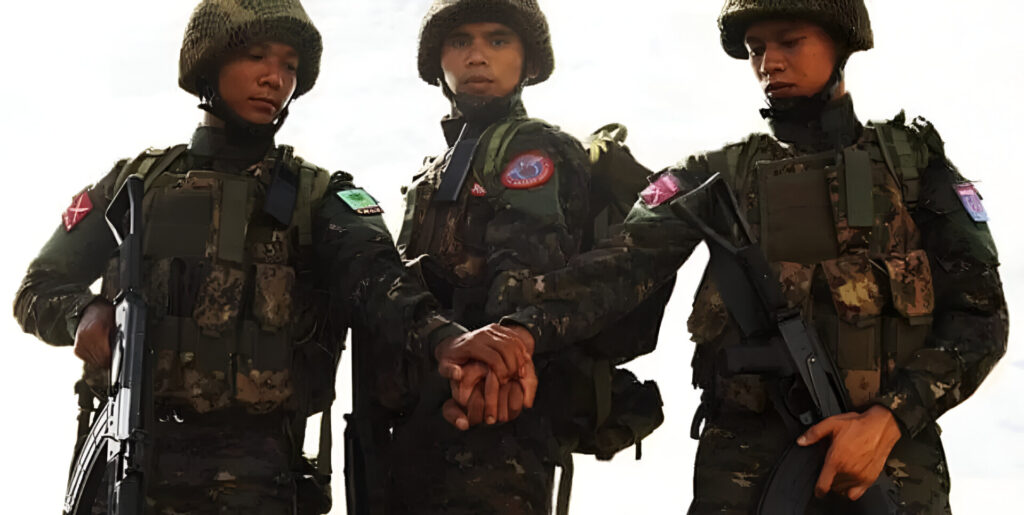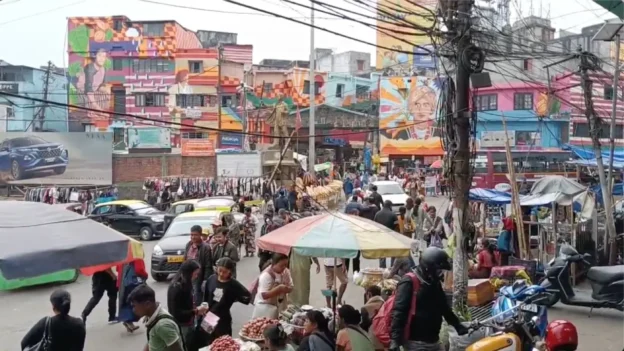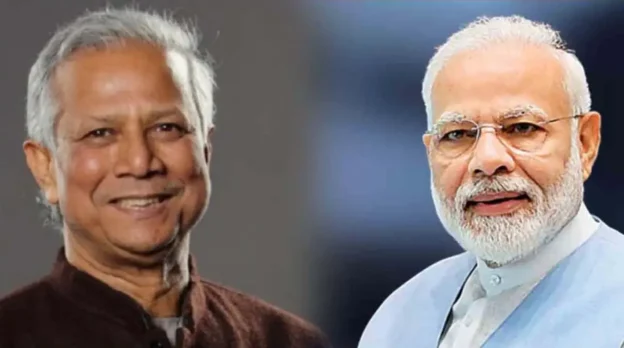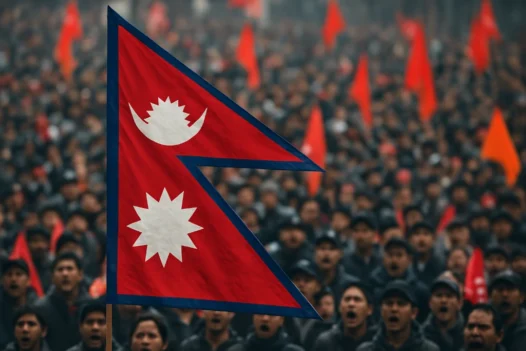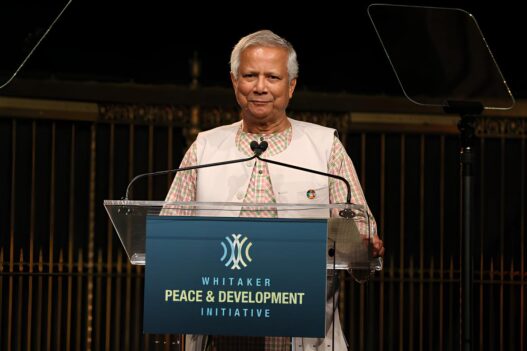On October 10, 2024, Myanmar’s prolonged civil war took a dramatic turn with the launch of Operation 1027, a large-scale, coordinated military campaign led by the Three Brotherhood Alliance (3BA)—comprising the Myanmar National Democratic Alliance Army (MNDAA), the Ta’ang National Liberation Army (TNLA), and the Arakan Army (AA). Over the past year, this offensive has drastically shifted the dynamics of the ongoing conflict, marking a significant transformation in both the resistance movements and the military junta’s (State Administrative Council, or SAC) ability to maintain control. The operation, focused primarily on northern Shan State and areas bordering China, has exposed the vulnerabilities of the military regime and altered the socio-political landscape of Myanmar, with far-reaching consequences for both sides.
The escalation of conflict: A shift in momentum
The launch of Operation 1027 marked the beginning of an intense escalation in Myanmar’s civil war. From mid-2024 onward, the Brotherhood Alliance ramped up its offensives, signalling the sustained commitment of the insurgents to push forward their campaign. The first major breakthrough occurred on August 3, when the MNDAA and its allies successfully captured the headquarters of the Northeastern Regional Military Command (RMC) in Lashio, located in northern Shan State. The fall of Lashio was a major shock to the military junta. It not only undermined the junta’s military command structure but also revealed the growing strength of the ethnic armed groups.
Lashio’s strategic location on National Highway 3, which connects Mandalay to China, made its capture a particularly damaging blow to the regime. The loss of this key town, which had long been a military stronghold, signalled that the junta’s grip on power in the region was weakening. For the Brotherhood Alliance, capturing Lashio was a symbolic and strategic victory, as it was one of the military’s primary logistical hubs for operations in the north.
In the wake of this success, the Brotherhood Alliance turned its attention to further targets that could further undermine the junta’s ability to maintain control over northern Shan State. Among these was Pyin Oo Lwin, located just 150 kilometres from Lashio. Pyin Oo Lwin is home to Myanmar’s Defence Services Academy (DSA), an essential military institution founded in 1954. The loss of Pyin Oo Lwin would have been a major blow to the junta’s training and military infrastructure, further isolating its forces in the north. As the insurgents seized more key towns along NH3, including Muse, Hsipaw, and Kunlong, the junta’s strategic position in the region began to collapse.
Kunlong’s fall, in particular, was highly symbolic. It had long been a gateway for the junta’s trade and logistical routes with China. Its loss disrupted the Myanmar-China trade corridor, a critical lifeline for the military regime. The junta’s inability to defend these border towns and key logistical points emphasized how the Brotherhood Alliance’s territorial control was steadily expanding.
Another critical loss for the junta occurred in Laukkai, the headquarters of the Kokang Self-Administered Zone near the Chinese border. The MNDAA’s capture of Laukkai further undercut the military’s control over the north and exposed the growing vulnerability of the regime. Laukkai had long been a hub for military operations, and the region was also tied to illicit activities linked to Chinese criminal networks. The fall of this region represented a significant erosion of the military’s presence in the area and further highlighted the growing pressure on the junta.
In an unprecedented development, several military personnel fled across the border into India in November 2024, reportedly escaping the deteriorating situation in northern Shan State. This marked a rare occurrence in the conflict, underscoring the junta’s increasingly tenuous control over its own forces.
Strategic Shifts and the Impact on the Junta’s Power
Since the initial successes of Operation 1027, the military junta has faced a difficult situation. Despite losing key territories and suffering significant setbacks, the junta retains control over major urban centres, including Yangon, Mandalay, and Naypyidaw. The military has also maintained its airpower and artillery, which it has used to launch heavy strikes against insurgent positions, especially in peripheral regions. While this has allowed the junta to maintain a degree of control over Myanmar’s strategic heartlands, it has struggled to regain its hold over the regions lost in the north.
The junta’s response to the growing threat has been to consolidate its power in the areas it still controls. Efforts have been concentrated in regions like Pyin Oo Lwin, where Myanmar’s Defence Services Academy is located. This facility, and others like it, remain crucial to the junta’s ability to train and deploy new soldiers, and to maintain control over its military operations. To shore up its position, the junta has relied heavily on airstrikes and artillery bombardments to suppress resistance forces. However, these tactics have proven less effective against the increasingly mobile and coordinated ethnic armed groups, who have demonstrated an ability to strike at key military positions and disrupt the junta’s supply lines.
In addition to direct military engagements, the junta has faced growing internal discontent. Reports of defections among the military ranks have increased, and the junta has been forced to implement stricter controls on its soldiers, including tighter surveillance, pay cuts, and the prevention of desertions. Despite these efforts, the frequency of defections and the declining morale within the ranks continue to plague the military’s ability to respond effectively to the growing resistance.
Coordination among ethnic armed groups: A key to success
One of the defining features of Operation 1027 has been the unprecedented coordination among Myanmar’s ethnic armed groups. The TNLA, MNDAA, and AA, previously fragmented by territorial disputes and differing political ideologies, united under the banner of the Brotherhood Alliance. This cooperation has proven to be a force multiplier for the resistance movement, allowing the ethnic groups to leverage their local knowledge and territorial control to launch successful offensives against the junta.
This unity among the ethnic armed groups represents a major shift from the past, where internal divisions and rivalry often hindered effective collaboration. The Brotherhood Alliance’s success in coordinating attacks on key military positions and disrupting the junta’s supply routes has demonstrated the growing strength of Myanmar’s ethnic resistance movements. The military’s inability to effectively counter this coordination has significantly weakened its position, particularly in border regions that were once considered secure.
In addition to the Brotherhood Alliance, the People’s Defence Forces (PDF), aligned with the National Unity Government (NUG), have continued to play a prominent role in the conflict. While the NUG did not directly orchestrate Operation 1027, it has voiced strong support for the offensive, viewing the Brotherhood Alliance’s successes as crucial in weakening the junta’s hold on power. The PDF’s involvement, alongside the ethnic armed groups, underscores the growing consolidation of anti-junta forces and the increasing complexity of Myanmar’s civil war.
However, despite the successes of the Brotherhood Alliance, tensions within the broader resistance movement have surfaced. Ethnic rivalries, particularly between the TNLA and groups like the Kachin Independence Army (KIA) and the Shan State Progress Party (SSPP), have created challenges for further coordination. The KIA, a major anti-junta force, was reportedly unaware of the planning for Operation 1027 and expressed reluctance to fully endorse the strategy. Similarly, the SSPP found itself in a difficult position as the TNLA expanded into contested territories, creating friction between groups vying for control of valuable land and resources.
Despite these internal challenges, the Brotherhood Alliance’s success in capturing key military bases and disrupting the junta’s logistical supply routes has signalled a new phase in the conflict. The growing coordination among the resistance groups has shifted the momentum in favour of the insurgents, leaving the junta scrambling to regain its lost ground.
The wider conflict: Rising intensity and casualties
Between June and August 2024, the intensity of the conflict spiked significantly. Reports indicated a sharp increase in attacks by insurgent groups, with 678 recorded incidents during this period, compared to 579 in the previous months. This surge in violence reflected the growing coordination among ethnic armed organizations, the PDFs, and other pro-democracy militias. The same reports also suggest that the military, already stretched thin by fighting on multiple fronts, has suffered a sharp rise in casualties. The number of fatalities among security forces increased by 42%, from 1,195 to 1,701 in just three months.
In response to these escalating attacks, the junta has attempted to clamp down on defections and desertions. The report cited above also suggest that the number of military personnel captured by insurgents decreased by 67% from March to August 2024, from 1,471 to just 480. This decline reflects the junta’s increasing efforts to tighten control over its forces, including more stringent surveillance and controls on soldier pay and incentives. Despite these efforts, however, the insurgents’ increasing territorial control and the growing frequency of clashes signal a weakening of the military’s ability to maintain control in peripheral regions.
While the PDF remains a dominant force in the resistance movement, accounting for 29% of all recorded attacks, its activity has seen a slight decline in recent month, the report adds. This has been attributed to both strategic shifts and resource limitations, but it also underscores the growing role of local militias and ethnic armed groups in challenging the military’s dominance.
The role of China: A complex calculus
China’s role in the conflict has grown increasingly important, particularly as the resistance has gained ground in northern Shan State, an area of strategic interest due to its proximity to the China-Myanmar Economic Corridor (CMEC), a key part of China’s Belt and Road Initiative (BRI). Historically, China has supported Myanmar’s military regime, but it has also maintained relationships with various ethnic armed groups, many of which are involved in cross-border trade and smuggling operations.
Beijing’s cautious approach to the conflict reflects its interests in maintaining stability along its southern border and ensuring the continued flow of trade. While China has been reluctant to directly intervene in the war, it has taken steps to limit the destabilizing effects of the insurgency, particularly with regard to criminal activities in the border regions. The death of a prominent Chinese crime boss, Ming Xuechang, in Myanmar in October 2024, highlighted Beijing’s concerns over the growing instability in Myanmar and its potential impact on its economic investments. However, China has refrained from openly supporting the insurgents, instead focusing on diplomatic efforts to secure a ceasefire and encourage dialogue between the junta and opposition forces.
A war in flux
As the year since the launch of Operation 1027 comes to a close, Myanmar’s civil war is entering a new and uncertain phase. The military junta’s position has been significantly weakened, particularly in the border regions, and the resistance movement—comprising both ethnic armed groups and the People’s Defence Forces—has gained considerable ground. While the junta still controls key urban centres and retains significant military capabilities, its hold on power is increasingly precarious.
The role of China, while crucial, remains ambiguous. Beijing’s strategic interests in Myanmar mean that it is unlikely to allow a total collapse of the junta’s power, but it is also mindful of the growing instability along its border. In the coming months, the trajectory of the conflict will depend on the military’s ability to adapt to the increasingly coordinated resistance, the stance taken by China, and whether internal divisions within the anti-junta coalition can be overcome.
For now, the war shows little sign of winding down. The success of Operation 1027 has forced the junta onto the defensive, but it is far from defeated. Myanmar’s civil war remains fluid, complex, and protracted—its outcome uncertain and fraught with potential consequences for the future of the nation.

